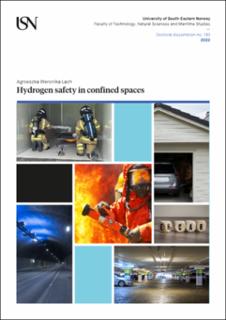| dc.contributor.author | Lach, Agnieszka Weronika | |
| dc.date.accessioned | 2022-08-24T04:06:23Z | |
| dc.date.available | 2022-08-24T04:06:23Z | |
| dc.date.issued | 2022-09-02 | |
| dc.identifier.isbn | 978-82-7206-678-8 | |
| dc.identifier.issn | 2535-5252 | |
| dc.identifier.uri | https://hdl.handle.net/11250/3013137 | |
| dc.description.abstract | Unwanted hydrogen releases in confined spaces can be significantly more dangerous compared to open-air scenarios. The transmission towards a zero-emission system results in a growth of hydrogen-driven vehicles which increases hazards and risk of accidents. Implementing hydrogen technologies into applications that are available to the public needs investigations of the many possible accidental scenarios. The knowledge should be disseminated to specialists, first responders and end-users. The experimental campaigns presented in this study are part of a pre-normative research project to develop a recommendation for Regulation, Codes, and Standards (RCS) and an engineering tool for hydrogen safety engineers.
Four experimental campaigns were conducted during this work to investigate the results from hydrogen releases in the worse case scenarios. The large and full-scale experimental setups were designed to investigate ignited and unignited hydrogen releases. The 15 m3 explosive chamber was used to investigate overpressures – from Pressure Peaking Phenomena in an enclosure similar to private garages. The 40 ft ISO container was used for the investigation of hydrogen dispersion and thermal effects from hydrogen jet fires in enclosures similar to carparks. The hydrogen releases were performed with mass flow rates from 1.4 g/s to 13 g/s from reservoir pressures from 27 bar to 700 bar through nozzle diameters 0.5 mm – 4.0 mm, depending on the experiments and experimental campaign.
The first two campaigns investigated the Pressure Peaking Phenomena from unignited and ignited releases. The experimental results were in good agreement with the developed analytical models, where the perfect mix assumption was confirmed. The model allows estimating the minimum ventilation area for the given mass flow rate and conversely. For the unignited hydrogen releases, the mass flow rate had to be relatively high and the ventilation area relatively small to observe the Pressure Peaking Phenomena. For the ignited releases the much lower mass flow rate will result in much higher overpressure compared to unignited releases for a similar ventilation size. The highest obtained overpressure for unignited releases was 8.1 kPa, resulted from the mass flow rate of 4.75 g/s and 0.0006 m2 vent area. The highest measured overpressure during ignited releases was 48.1 kPa which resulted from the mass flow rate of 8.62 g/s and 0.0055 m2 vent area.
Experimental campaigns in the 40 ft ISO container were imitating hydrogen releases from the car – hydrogen jets impinging on the floor (90° - unignited jets and 90° and 45° - ignited jets). During the first experimental campaign in the 40 ft ISO container, the mechanical ventilation was investigated for 6 and 10 air changes per hour. The results showed influence on the time when the cloud is flammable but not for the maximum concentration in the cloud. The second experimental campaign in the 40 ft ISO container investigated thermal effects from hydrogen jet fires. The temperature results showed safe access to the car in case of an accident and the most dangerous areas. The temperature in the ventilation pipe did not exceed 300 °C from all releases. While inside the container, under the ceiling, this temperature limit of 300 °C was not exceeded only from releases through a 0.5 mm diameter. | en_US |
| dc.language.iso | eng | en_US |
| dc.publisher | University of South-Eastern Norway | en_US |
| dc.relation.ispartofseries | Doctoral dissertations at the University of South-Eastern Norway;130 | |
| dc.relation.haspart | Article A: Lach, A.W., Gaathaug, A.V. & Vågsæther, K.: Pressure peaking phenomena: Unignited hydrogen releases in confined spaces – large-scale experiments. International Journal of Hydrogen Energy, 45(56), (2020), 32702-32712. https://doi.org/10.1016/j.ijhydene.2020.08.221 | en_US |
| dc.relation.haspart | Article B: Lach, A.W. & Gaathaug, A.V.: Large scale experiments and model validation of Pressure Peaking Phenomena-ignited hydrogen releases. International Journal of Hydrogen Energy, 46(11), (2021), 8317-8328. https://doi.org/10.1016/j.ijhydene.2020.12.015 | en_US |
| dc.relation.haspart | Article C: Lach, A.W. & Gaathaug, A.V.: Effect of Mechanical Ventilation on Accidental Hydrogen Releases—Large-Scale Experiments. Energies, 14(11), (2021), 3008. https://doi.org/10.3390/en14113008 | en_US |
| dc.relation.haspart | Proceeding A: Lach, A.W. & Østby, T.G..: Parameter estimation using Bayesian approach for a model of Pressure Peaking Phenomena-ignited H2 releases. Proceedings of the 61st International Conference of Scandinavian Simulation Society, SIMS 2020, p. 443-450, 2021. https://doi.org/10.3390/en14113008 | en_US |
| dc.relation.haspart | Proceeding B: Lach, A.W. & Gaathaug, A.V.: Pressure peaking phenomena: Large-scale experiments of ignited and unignited hydrogen releases. Proceedings of the 13th International Symposium on Hazards, Prevention and Mitigation of Industrial Explosions, p. 813-826, 2021. https://doi.org/10.7795/810.20200724 | en_US |
| dc.relation.haspart | Proceeding C: Lach, A.W., Gaathaug, A.V. & Vågsæther, K.: Thermal effects from downwards hydrogen impinging jet flame – experimental results from high-pressure releases in a carpark. Paper submitted to the 10th International Seminar on Fire and Explosion Hazards, May 2022 | en_US |
| dc.relation.haspart | Co-article A: Cirrone, D., Makarov, D., Lach, A.W., Gaathaug, A.V. & Molkov, V.: The Pressure Peaking Phenomenon for Ignited Under-Expanded Hydrogen Jets in the Storage Enclosure: Experiments and Simulations for Release Rates of up to 11.5 g/s. Energies, 15(1), (2021), 271. https://doi.org/10.3390/en15010271 | en_US |
| dc.rights.uri | http://creativecommons.org/licenses/by-nc-sa/4.0/deed.en | |
| dc.subject | hydrogen safety | en_US |
| dc.subject | Pressure Peaking Phenomena | en_US |
| dc.subject | large scale experiments | en_US |
| dc.subject | hydrogen dispersion | en_US |
| dc.subject | hydrogen jet fires | en_US |
| dc.subject | overpressures | en_US |
| dc.subject | mechanical ventilation | en_US |
| dc.subject | thermal effects | en_US |
| dc.title | Hydrogen safety in confined spaces | en_US |
| dc.type | Doctoral thesis | en_US |
| dc.description.version | publishedVersion | en_US |
| dc.rights.holder | © The Author, except otherwise stated | en_US |
| dc.subject.nsi | VDP::Technology: 500::Environmental engineering: 610 | en_US |

